Science Centre Showoff
Live on location at the Cambridge Science Centre, Chris Smith, Dave Ansell, Ginny Smith and guests Rod Jones, an atmospheric chemist, Margaret Stanley, an HPV cancer researcher, and Caroline Goddard, jet engine metallurgist, pit their wits against the assembled public. Plus Dave and Ginny make crisp packet fireworks, prove you can't be heard screaming in space and make an elastic-band-powered fridge...
In this episode
02:51 - Science Centre: Gravity Defying Mug
Science Centre: Gravity Defying Mug
with Dave Ansell, Ginny Smith, The Naked Scientists
Dave - So, I've got a lovely little demo here. I have a mug on a piece of string and 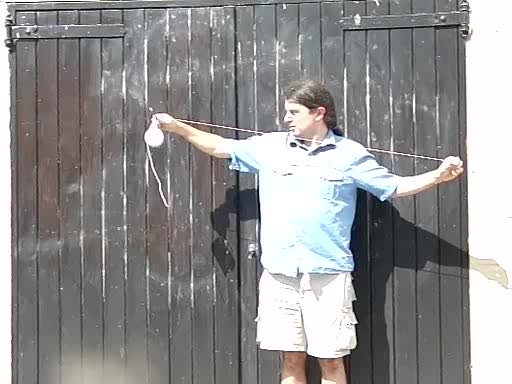 on the other end of the piece of string is a little nut, of the metallic variety. So in fact, it's a M8 nut. The fact I know that from just looking at it, is slightly worrying.
on the other end of the piece of string is a little nut, of the metallic variety. So in fact, it's a M8 nut. The fact I know that from just looking at it, is slightly worrying.
We're just going to run the string over the top of a mug and undo the knot in it otherwise, it's going to go horribly wrong....
Chris - So basically Dave, you've tied a mug, a china mug onto a lump of string and you got a little nut on the end of that 1-meter long bit of strong and a biro. You put the string over the biro.
Dave - The string is run over the biro. So, at the moment, I'm holding on to the nut. So, that's holding up the mug. And now, I'm going to let go of the nut.
Chris - It might go smash.
Dave - Okay, so 3, 2, 1...
Chris - Now, for the benefit of people that aren't actually able to see this because they're on the radio, Ginny, tell all.
Ginny - So, the mug looked like it was going to fall. Obviously, once Dave let go of the string, gravity was pulling it down and it fell quite a long way, but stopped about a foot from the floor. If we look closely, we can see what happened is that the nut has swung and wrapped itself around the biro several times and that's holding it in place. Why has that happened?
Dave - So, as the nut starts to fall, it starts to spin around the biro and as the string gets shorter and shorter, and shorter, it's a bit like climbing to the middle of a roundabout. As you climb to the middle of a roundabout, the roundabout gets faster and faster, and faster. So, the string spins around and round, faster and faster, and faster, until it's going fast enough to wrap around enough times that it doesn't fall out on the floor and smash.
Ginny - Probably not one to try with your mom's best china.

05:07 - A Pollution Tester for Your Pocket
A Pollution Tester for Your Pocket
with Professor Rod Jones, University of Cambridge
Professor Rod Jones is a Professor of Atmospheric Physics in the Chemistry 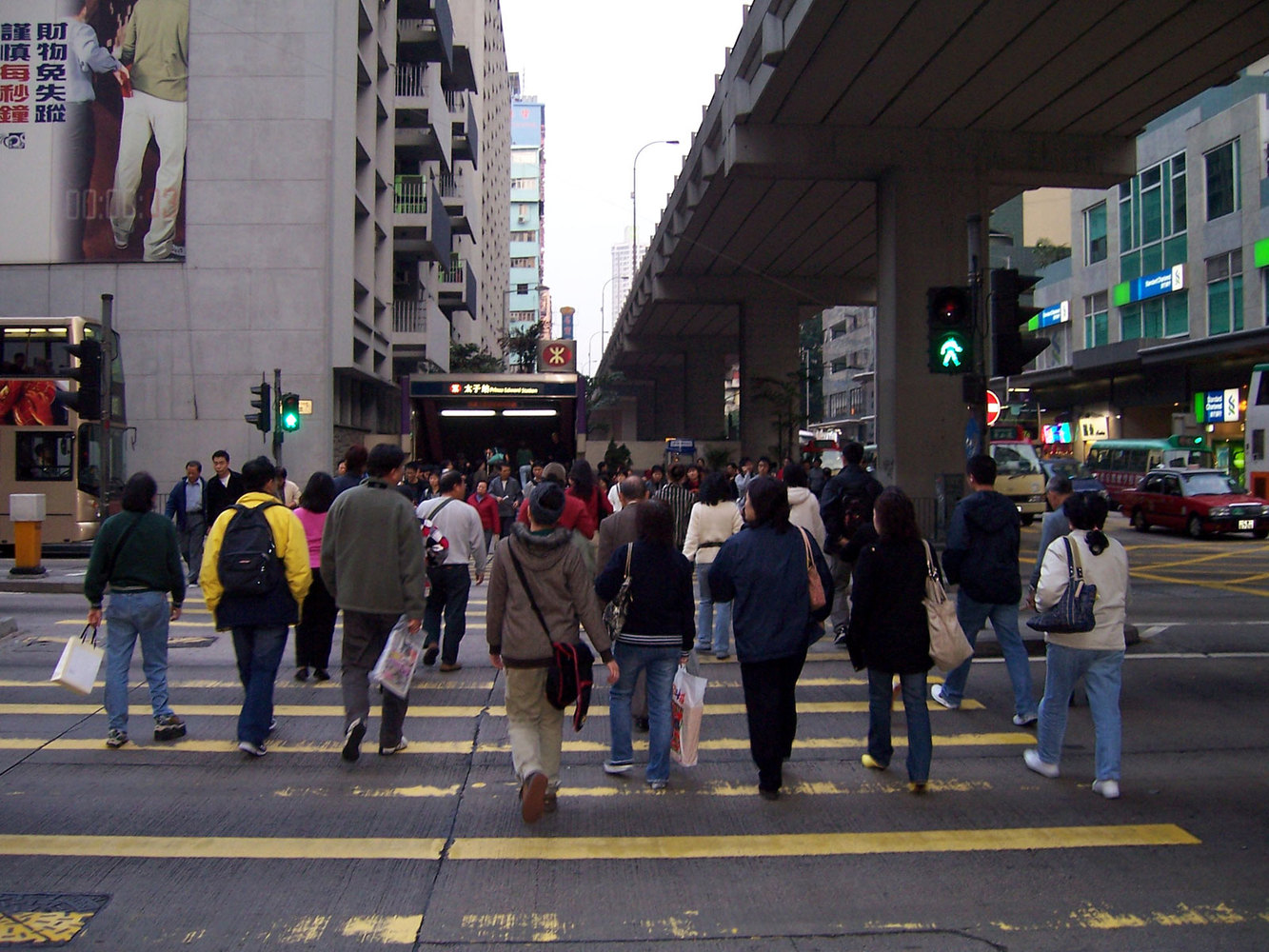 Department at Cambridge University. He explained explained how he's developed a pollution detector which fits in your pocket to Chris Smith and an audience at the Cambridge Science Centre...
Department at Cambridge University. He explained explained how he's developed a pollution detector which fits in your pocket to Chris Smith and an audience at the Cambridge Science Centre...
Rod - Well, I do lots of different things, all the way from looking at the ozone layer, through to looking at climate change. But tonight, what I've brought along is one of the very small sensors that we make so that we can actually look at air pollution and try to understand how air pollution itself works and then we try and build slightly more sophisticated gizmos which allow us to monitor what a person walking the streets might be exposed to.
So, inside this box which the people can see here, those on radio, it's about 20cmx8cmx2cm it's got one nice green button which is the GO button and inside it, there is a mobile phone. I'm going to hand it out in a minute and what this does, it's also got a navigation system inside so that we can know where it is. We have three different gases being measured, somebody can put this in their pocket. We know where they are, we know what they're exposed to.
Chris - How do you know where they are?
Rod - Well, because we've got what's called a GPS aerial inside it, which is what you need in your car satnav to help you navigate. And so, inside here, there's a mobile phone. We have a satnav effectively, and we have some chemical sensors. So, we can actually monitor every second or so, what a person is being exposed to, and then we can relate that back to what we know is causing pollution in the town. We can also relate it back to somebody getting more asthmatic or wheezy as they go through a more polluted area. So, we're trying to conduct experiments which are linking those two.
Chris - Why is this better than what we have already?
Rod - It's better because you'd have a real problem in putting conventional instruments into your pocket. They weigh about 60kg and they're about the size of this table.
Chris - So, how have you managed to make it so small?
Rod - Well, we've taken sensors which are traditionally used in alarm systems and we've just made them better, and about a thousand times more sensitive. We can now make them about a thousand times smaller, which is what you can see here, what the audience can see here. Because we can make them really small, we can now make them much more portable and we can just give them to people to carry around.
Chris - What can you detect with it?
Rod - Well, these little chappies can just detect gases like carbon monoxide and nitrogen oxides. We've got other ones which can do other gases as well, but nitrogen oxide is particularly well-known or thought to be associated with health impacts. So, that's one gas that we can go for.
Chris - Let's take some questions. Get your hands up in the air if you'd like to ask anything. Let's start down here at the front. Who are you sir?
Mujal - I'm Mujal. I live in Cambridge. I just wanted to ask, what is air pollution and how do you measure it?
Rod - Well, air pollution that we're worried about is probably nitrogen oxides which come from cars. It's probably particles that come from cars and buses particularly. A lot of it is linked to transport, but those are the principal gases that you'd expect us to link to air pollution and those are the ones which are monitored by the national networks.
Chris - Who's next? What's your name sir?
Elliott - Elliott. How long does it take to make one?
Rod - Gosh! Well, to design and build one from first principles, it takes a few years. But once you know how to do it, it probably takes a few minutes.
Chris - So, there's hope for you yet, Elliott. You can do it with Lego perhaps. Yes, madam.
Ailish - Hi, my name is Ailish. I live here in Cambridge. I was just wondering you mentioned putting the device in your pocket. How accurate a test would that be compared to breathing in harmful chemicals?
Rod - That's a very good question. Of course, if you put it in your inside pocket, not very accurate. So, what we're actually doing and I've not brought them along this evening is make much smaller versions of these which effectively, you can put on your lapel much closer to where you breathe in. So, we're trying to get closer and as we build these things smaller and smaller, we can put them in much more sensible places.
Chris - Can I just ask a quick question, Rod? What happens if you put it in your trouser pocket and you've had beans?
Rod - Well, we don't measure methane.
Chris - But isn't that quite an important greenhouse gas?
Rod - It is an important greenhouse gas and in fact, I don't know whether you're trying to lead me into another area, but we've got other sensors just like this which are designed to measure greenhouse gases so that we can for example work out how much CO2 Cambridge is emitting. Not methane yet, but we could go that far, but I'll keep that for another story I think.
Chris - What's your name?
Laura - Laura.
Chris - Hello, Laura.
Laura - Once we've created pollution, can we get rid of it?
Rod - Gosh! That's another very good question. Well, it gradually decays in the atmosphere. Even when it rains, we get rid of a lot of pollution, but some pollution takes quite a few months to get rid of. So, there's a natural process of getting rid of it, but if you're emitting it locally then you can easily get very high concentrations even though you're losing it gradually. It's like filling a bath.
Chris - What's the amount of time that carbon dioxide, once it comes out of the exhaust pipe of a car or whatever for instance stays in the atmosphere once we've released it? How long is it around for causing a greenhouse effect?
Rod - Well, of course, carbon dioxide isn't a pollutant - an air quality pollutant - in the way that we were talking about a couple of minutes ago. But once it comes out of your tail pipe, it's probably in the atmosphere for 100 or 200 years.
Chris - So, anything we emit now, we've potentially got to deal with for 100 or 200 years. We got to live with their consequences for that long.
Rod - Yes, I think that's absolutely right.
Carlo - Good evening. My name is Carlo and I would like to know when we walk in the street, are children more exposed to pollution than adults are because maybe adults are taller or does it make no difference?
Rod - We're looking at that and the effect doesn't seem that great. Of course, if you park your buggy at the exhaust of a bus, you're in trouble. But actually, what's really important quite often is which side of the street you walk on. And so, one of the things we're leading towards doing is developing a phone app to tell you which side of the street you want to walk on if you want to take a low pollution route. So, that's good question.
Chris - That could mean that everyone takes that route and then they walk really slowly because they're all stuck behind the slowest person in the world who is inevitably going to be on that same pavement. Then you get more exposure because you got to breath the air for longer.
Rod - Well, that's probably true so maybe we should...
Chris - You have to factor that into the app. One more question here.
Errol - Hi, Errol. How many data points do you actually need to get a good map of a town? So, how many people carrying it for how long to give you a really good sort of map of pollution across say, a city centre?
Rod - We've been trying for years to get that number and we haven't got there yet. Every time we can make a measurement with more sensors, we see more detail. So, we're trying to unpick that problem at the moment.
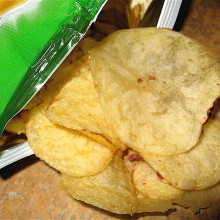
12:17 - Science Centre: Crisp Packet Fireworks
Science Centre: Crisp Packet Fireworks
with Dave Ansell, Ginny Smith, The Naked Scientists
Ginny - There seems to be a lot of rubbish on this table. Have you just been eating, crisps? And what's with these plates? I don't think I'd want to eat my dinner off that.
Dave - Well, also on this table, I have a microwave.
Ginny - Yeah, I thought that was just for your dinner as well.
Dave - I get quite peckish, so this is understandable. So, the rubbish we have is a crisp packet and crisp packets are quite beautiful things. They're shiny on the inside and they kind of plasticky on the outside. What we have here is a microwave oven. Now, the way a microwave oven cooks is by essentially causing electric currents to flow backwards and forwards inside the food. Food isn't a very good conductor, so it doesn't get very hot. However, the shiny aluminium inside a crisp packet conducts electricity really quite well. Aluminium is almost as good a conductor as copper.
Ginny - Now, I've always been told not to put anything with metal on it in the microwave.
Dave - This might explain why. Probably, a crisp packet is the one thing that with permission isn't too bad in a microwave. But anything else with metal is a really, really bad idea. So, I'm going to open the microwave and I'm going to put the crisp packet into the back of the microwave. Hopefully, that should be standing up.
Ginny - Okay, so we've now got a crisp packet in a microwave and we probably want to put the house lights down around now so that people can see what's going on, and then you're going to turn on the microwave?
Dave - So I'll turn on the microwave, this should cause lots and lots of electric currents to flow inside the crisp packet and that might make it a bit warm.
Ginny - So, we got what looked like a whole load of sparks going out from inside the crisp packet. If there was just a current flowing through there, why did we get sparks?
Dave - So, first thing, I'm going to very, very carefully go in and because it could be very hot and take the crisp packet out.
Ginny - Okay, that doesn't look like it would be much use for holding, crisps anymore. It's all scrunched up. It's kind of melted into one blob. It doesn't look very appealing.
Dave - So, it has shrivelled up in the same way as if you put a crisp packet on a fire, it gets hot and it shrinks, and shrivels up. As it's doing that, it kind of bends and you get big electric currents flowing through it and all of a sudden, you can get bits getting close to each other. There's kind of a shortcut the electricity can take through the air and it jumps through the air and produces sparks. As it shrinks, the bubbles get close to each other. You get sparks and you get these rather exciting noises which I'm sure you heard.
Ginny - So, it's a little bit like lightning except it's jumping a much smaller distance than lightning does.
Dave - Exactly, right, yes.
Chris - Ginny and Dave, thank you very much. Anyone got any questions? We have one down the front here. What's your name, madam?
Joti - Hi. I'm Joti. I live in Cambridge. You can put food in the microwave on aluminium foil and it's absolutely fine. It heats up. So, how does that happen?
Dave - I think aluminium will get hot in a microwave if the microwaves can get to it, it will get hot. But if it can't shrink because with the crisp packet it was shrinking and you get the small gaps where the electricity can jump as sparks, you don't necessarily get sparking. You do get sparking off things like gold rims on plates because then you get a little break in the gold rim and then you get sparking across that. I wouldn't necessarily say it was a good idea in general, but I can quite believe that it works.
Ginny - So, you only really get sparks when you've got something that can conduct the electricity, but then a point where it can't conduct it anymore and it has to jump through the air. So, because the crisp packets have a sort of plasticky coating, that can't conduct the electricity anymore. So then, when the electricity reaches that point, it has to jump and that's why you get the sparks.
Chris - We have a question down the front here. What's your name?
Nathan - Nathan.
Chris - Hello, Nathan. What can we do for you?
Nathan - I was just wondering if you would be able to do that again.
Ginny - Dave is just going to set it up again. We're going to put the crisp packet back in the microwave and turn the house lights down, and then we'll set it going. There we go.
Chris - Okay, next question. Yes, sir, down the front here in the black t-shirt. What's your name?
Ashley - Ashley.
Chris - Hello, Ashley. What would you like to know?
Ashley - What will happen if you tried to cook food in a crisp packet like that?
Ginny - Well, as you saw, the crisp packet kind of shrivelled up and melted. So, I think what you would find is you'd have bits of melted crisp packet stuck to your food. It will probably also burn in places.
Dave - And hot plastic doesn't taste good, I've found from experience so I wouldn't recommend it.
Ginny - No, I don't think it will be the best way to cook your dinner.
Chris - Okay, there's one more question here. This gentleman just in the second row here. What's your name?
Aaron - Aaron.
Chris - Hello, Aaron.
Aaron - So, if it takes electricity 10,000 volts to jump a centimetre, how many volts were in that crisp packet when it's sparking?
Dave - There was certainly - there will have been thousands of volts. The electricity kind of sloshs backwards and forwards through the crisp packet. And as it does that when it kind of slams into one end, you get very, very high voltages.
Chris - Just over here, yes, sir.
Fergal - My name is Fergal. I know hot plastic doesn't taste good, but is there any health risk associated with cooking food in plastic dishes in a microwave?
Chris - Ready meals.
Ginny - So, yeah. I think the answer is that they do do tests on things like that. So, I think anything where your food sold in a plastic thing that says you can put it in a microwave, they would've tested that and they would've shown that the chemicals weren't going to harm you. If it's something that's not microwave safe then if it melts then you actually end up ingesting more of that plastic because it's melted into your food. That's probably not going to do you much good.
Dave - There are some plastics which when you get them hot, do give off bad chemicals but they would deliberately pick them not to use in food packaging. The really nasty thing about the hot plastic when it starts to burn, you get lots of nasty chemicals and hopefully, you're not burning your food too badly when you're cooking a ready meal.
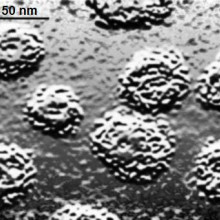
19:17 - Developing the HPV Vaccine
Developing the HPV Vaccine
with Margaret Stanley, University of Cambridge
Virologist Margaret Stanley explained her work developing the HPV vaccine, aimed at lowering 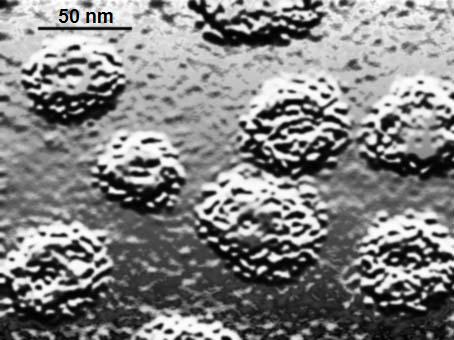 the rates of cervical cancers to Chris Smith and an audience at the Cambridge Science Centre..
the rates of cervical cancers to Chris Smith and an audience at the Cambridge Science Centre..
Margaret - Well, I work on viruses called papillomaviruses. They're incredibly interesting because they only live in the epithelium that covers your body like the skin and the interior of your mouth and the interior of the reproductive tract, and your back passage. Most of the time, these viruses do no harm. In fact, if you ever see - an effective one it's likely to be a wart. But they're a huge family and like all families, they have black sheep.
The black sheep of this big family cause cancer. The cancers they cause, the big one is cancer of the cervix in women. Now, that is a huge problem in the world. It's the second commonest cancer in women worldwide. In Sub-Saharan Africa, it's the commonest cancer in women. So, we're talking about a really serious disease. Now, it's not just the cervix. In men and women, it causes cancer of the anus which is the back passage. It causes cancer of the tonsil and it also causes cancer in women in the vagina and vulva. So, we're talking about something really important. In fact, 5% of all cancers are caused by these viruses to one in particular...
Chris - How does it cause cancer in those places?
Margaret - Well, that's a very interesting question. First of all, the virus doesn't intend to cause cancer. Cancer for a virus is a dead end because viruses exist to make more viruses and that means they have to reproduce. Now, when viruses cause cancer, they are no longer able to reproduce in the cell, so it's a bad news for the virus.
It's because these viruses, particularly this 116, carries two genes which are really important for the virus to reproduce. But if those genes are expressed in the wrong place in the epithelium because epithelium we're talking about looks like a brick wall. Normally, these two genes in the virus are made in the upper parts of the bricks. But in the cancers, they're made right in the bottom and that's absolutely the wrong place because that's where the cells are dividing. These genes distort the way cells divide and that's...
Chris - So, the virus puts those genes into the cells and makes the cells grow more than they should.
Margaret - Grow more than they should and not only that. It stops them distributing their DNA and their chromosomes properly. So, they end up with abnormal numbers of chromosomes and they end up able to accumulate more and more errors. That's how cancers develop.
Chris - So, how did you turn the virus into a vaccine that could prevent those diseases? How did you do that?
Margaret - Well, what you have to do is prevent infection with the virus. We can't act on the cancer, but what you can do is prevent women and men being infected by this virus by giving them a strong immune response. And so, what you do, this is what's been so interesting is we make shells of the virus particle. A virus looks like an egg. It's got a shell and what you do when you make the vaccine is, you make the shell, but you don't have the interior, you don't have the DNA. This shell, to the body's immune system, is exactly like the real virus and it makes antibodies to the proteins in the virus shell.
The big technical advance was being able to make these shells we call them virus-like particles. They're incredibly effective. They generate really strong defence responses and we know that these vaccines work. We know they work because the vaccines are now being laid out in certainly the industrialised world. In Australia in particular where they've been vaccinating since 2007, we can already see the decline in infection with the virus and we can see the decline in the pre-cancers caused by these viruses. So, it's a triumph.
Chris - Let's take some questions. First one over here...
Julian - My name is Julian.
Chris - Hello, Julian.
Julian - You were talking about vaccination and we have a policy in this country to offer vaccination to teenage girls for human papillomavirus. Do you think we should extend that to teenage boys as well?
Margaret - Yes. You're talking to the converted. The policy of giving it to girls was developed because at the time when all these policies were being generated, focusing on cervical cancer was the focus. But now, in the time that's elapsed, we've got a lot more information. So, we know how much male cancer there is. Basically, if you leave 50% of your population unprotected, then you've always got a great big pool of susceptibles. So, it's a much more sensible policy to immunize everybody. Then you don't have to worry how long the protection's going to last because everybody's protected.
Chris - Yes, madam.
Joti - My name is Joti and I'm from Cambridgeshire. Is there any selective population who is more susceptible to the viruses?
Margaret - No, that's another thing. If you went out and took a million women, we know that probably 800,000 of them would get infected, just because that's the way that virus transmits. But we don't know why some people are susceptible and can't get rid of it. It's not to do with ethnicity. It's not to do with behaviour. ..
Jodi - Haplotype?
Margaret - Haplotype, no. We do not have a handle on what the immunogenetics are, what is it about an individual and their ability to defend themselves against this virus.
Chris - Why is it Margaret that you catch it, but then you don't get the cancer for years?
Margaret - Because you get rid of it. Most of it, you get rid of. But also, you're looking in those people who develop the cancers, you're looking at chance events. You're looking at the probability of a molecular accident. Now, you can do the statistics - how often do mutations occur? So these are chance events and that's why it takes time.
Chris - Yes, sir.
Alex - Hi. My name is Alex. I'm from Cambridge. I have two very quick questions for you. The first is, you said we're all exposed to these viruses and yet, we need a vaccine to make an immune response so why is that? And secondly, you also said that we couldn't make a vaccine against the cancer. Why can't we make a vaccine against the cancer since the cancer would also have these viral particles in it?
Margaret - First question, I forgot it.
Chris - If we can make an immune response to the vaccine, why can't you just use your own immune response to boot virus out?
Margaret - Okay. This is a virus that only lives in the skin. Because of that, it is not very well exposed to the immune system. Now, you have to get into the circulation to the lymph nodes to generate a good immune response. And so, actually, in natural infections, you don't make a good immune response to this virus. Even though it's a pretty lousy immune response, still most people actually manage to get rid of it. The real issue for whether you're going to get cancer or not is whether you're one of those individuals who cannot clear this virus, cannot get their immune system to really deal with it. And I don't know who these people are, which is why you immunise everybody to give them a strong immune response because when you are immunised, you put your vaccine into the muscle. So, you go way beyond the skin and that way, you get straight into the lymph nodes to where the body really generates its defences.
Chris - Just very briefly Margaret, the second question which is, we can vaccinate against the virus. Why can't we just vaccinate against the cancer?
Margaret - Because cancers as they develop have evasion strategies which evade the immune response, which deregulate the immune response. So, it's a bit like turning a huge tanker around, trying to generate an immune response against the cancer that's going to be effective because that cancer has spent 15, 20 years, avoiding the immune response in the host.
Chris - It's become quite well practised We've got time probably just for one more question, young lady just down here.
Grace - Hi. My name is Grace and I just wondered why some people get cancer and others don't.
Margaret - If I knew that question, I'd be on the plane to Stockholm for the Nobel Prize. Some people are susceptible to these virus infections. Cancer is not one disease. It's a word that describes many diseases which occur in particular sites. So, I'm talking about cancer in the cervix and I know what causes that cancer which is a virus. But if I was talking about cancer in the breast, I don't know what causes cancer in the breast. I don't know why some women get it and others don't. Each cancer has its own profile, has its own risks, and these are different to a cancer in a different site. So, I can't answer your question properly.

29:58 - Science Centre: Bell Jar
Science Centre: Bell Jar
with Dave Ansell, Ginny Smith, The Naked Scientists
What happens in a vacuum? Dave and Ginny remove the air from a bell jar to see if you can scream in space...
Ginny - Okay, next to the microwave, you've got another quite interesting contraption. What I can see is what looks like a sort of old fashioned alarm type bell inside a Perspex tube, why are we looking at this?
Dave - So basically, I have a sealed Perspex tube and inside of it there's a bell and if I press the button, to make the bell ring, you can hear the bell really quite well. You can also see the little fan in there, blowing air around. You can see there's some air moving inside. So, what I'm going to do now is a really, really classic experiment. What I've got this tube attached to is something called a vacuum pump. It's a bit like a really, really hardcore vacuum cleaner. A normal vacuum cleaner can take out about 10% of the air from something. This will do about 99% if you give it long enough. So, if you listen to the bell at the moment, it's quite noisy and I will slowly pump the air out.
Ginny - So, that's quite noisy as well.
Dave - Yeah, vacuum pumps aren't the quietest of devices. What you can hear when I'm talking to you is that when I'm talking, I make the air in front of my mouth vibrate. And so, the air moves backwards and forwards, and the air in front of that bashes into the air in front of that which bashes the air in front of that. And eventually, unless you're listening to me on a radio when the loud speaker in the radio makes the air vibrate. So the air bashes and bashes, and bashes until it gets to your ear, and that makes your ear vibrate, and you can hear me talking. So, what we're doing here is we're slowly taking the air out of the tube. So, the bell should hardly be able to make the air move to start with and then the air is so thin that it shouldn't be able to - any vibrations in that are going to have hardly any effect on the rest of the world and hopefully, it should be quite quiet.
Ginny - What I can see is that where the little fan was blowing some bits of tin foil around, they don't look like they're moving anymore. So, have you turned the fan off?
Dave - If you look carefully, the fan is still running. So, what I've done instead of doing that is I've taken the air away. So now, if we try ringing the bell, it's almost entirely quiet.
Ginny - Yeah, you can sort of hear that something is going on, but it's definitely not the kind of bell noise you could hear before.
Dave - And you can see the clapper moving, but it's very, very quiet. If I let the air back in again which take a while...
Ginny - If I press the bell while you're letting the air back in, we should be able to hear it starting to get louder. Can you all hear that?
Chris - So Dave, answer the age-old question, could someone hear you scream in space?
Dave - That depends, if you're actually out in space then there's no air there, so no. But if you're in a space station then yes, because there's air.
Chris - Dave and Ginny, thank you very much. Who's got some questions? We have one just here. This person, what's your name?
Laura - Laura.
Chris - Hello, Laura.
Laura - When you practice at home, does anything ever go seriously wrong?
Chris - Come on Dave, now it's time to be honest.
Dave - I've broken lots of things. I haven't killed myself yet which is always a good thing. I haven't badly injured myself. So, I think that's pretty good.
Chris - There's question over the back here.
Paul - Hi. My name is Paul. I come from Hardwick. When you're talking about vacuums, they keep telling is that space is vacuum but they keep talking about solar winds. How can there be wind in space in a vacuum?
Dave - You can never get a perfect vacuum and there's always a few particles left. If you go into deep, deep space, there might be only one or two in every cubic metre whereas in a normal air, there's hundreds and hundreds of billions, if not, more than that. And so, the vacuum in space is very, very good, better than anything you could get without really, really, expensive kit. You're talking millions of quid on Earth. But it doesn't mean there aren't still some particles there and the sun does throw off some little hydrogen nuclei and they get thrown out at incredibly high speed. And so, there's a little bit there.
Chris - I think the speed of it is about a million miles per hour that it goes extremely fast.
Dave - It's really scarily fast, but there's not very much of it so it doesn't do too much damage of moving things around very much.
Chris - It's also responsible for the aurora when it strikes the magnetosphere around the Earth.
Dave - It gets deflected by the Earth's magnetic field and then piles into the north and south poles, and gives lots of energy...
Chris - Makes Norway a lot of money out of its tourist trait, very nice. There's another question over here.
Fergal - This is Fergal again. I'm wondering how does the speed of sound depend on the air pressure, so, as you travel out into space and you were to do an experiment?
Dave - Interestingly, it hardly changes at all because the speed of sound is to do with the ratio between the density and the kind of springiness. And as you reduce the pressure, you reduce the density but you also reduce springiness, and that cancels out. What it does depend on is temperature. The lower the temperature, the lower the sound because you kind of reduce the springiness without reducing the density; at high temperature goes very fast, at low temperature it goes very slow. Which is the reason why if you fly up where the jet planes fly, it's about minus 30 degrees centigrade at which point the speed of sound is about 600 miles an hour not 700.
Chris - Does that affect when you would get a sonic boom then? So, higher up in the atmosphere, you'd go slower to break the sound barrier.
Dave - Yes, it is easy to break the sound barrier when you're higher up. You don't have to go nearly as fast.
Chris - Fantastic! Any other questions for Dave and Ginny. One in the front, another one.
Paul - It's me again, Paul. We just heard that Voyager left the solar system. How? What's making it move for all these years?
Dave - Okay, so essentially, Voyager had a big rocket on it and it was going really, really fast. It kind of did some cunning manoeuvres going around the different planets, especially Jupiter which gave it extra kick. Basically, it's just going so fast that it has enough energy to keep on going forever. It'll keep on going straight out the solar system and go. So, if you shoot something out of a gun fast enough, it won't come down.
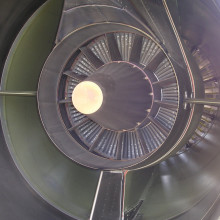
36:11 - What Metals Make A Jet Engine?
What Metals Make A Jet Engine?
with Caroline Goddard, University of Cambridge
Material Scientist, Caroline Goddard, explained to Chris Smith and an audience at the 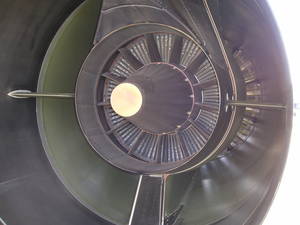 Cambridge Science Centre, how new alloys are made and how you select metals for different tasks...
Cambridge Science Centre, how new alloys are made and how you select metals for different tasks...
Caroline - I work on developing alloys which is when you mix a couple of metals together, a bit like baking, you mix things together, heat it up, see what happens. So, the reason we do this is because essentially, when it's in its pure state, metal isn't that good. You need to add something else to it that's got some good properties that you also like to it to make it much better. For example, steel is made up of iron and carbon. The carbon is what makes it strong and more brittle.
Chris - So, what is the difference between iron and steel? If I looked down a microscope, they're both iron, right? But it's just the trace element carbon that's there. Why does it make a difference?
Caroline - So, the carbon sits in the spaces between the iron atoms which stops the atoms from moving around which makes it much, much stronger.
Chris - Why is it then that a piece of iron, if I just put it out on the street will go rusty, but stainless steel doesn't?
Caroline - Stainless steel includes another element which is really, really environmentally resistant, which is chromium because chromium reacts with the oxygen and creates this layer of oxide on the surface which prevents it from corroding. So, if you put some chromium into your steel then you'll get this layer on the surface which prevents it from rusting.
Chris - Tell us about the jet engines because I'm dying to know what you do with those. How does one work? Just a simple starter for 10 points.
Caroline - So, a jet engine works by, air goes in through the front and is compressed as it moves through the engine. It's compressed really, really small and then at that point, it gets really hot. You inject some fuel into it and ignite it, and the air expands very quickly, and goes out back of the jet engine which creates some thrust. This expulsion of air creates enough power to turn the turbines in the engine which turns a huge fan at the front which you've probably all seen when you fly off in your holidays which sucks in a huge more amount of air which flings it back, which makes the plane go forwards.
Chris - Brilliant! Suck, squeeze, bang, blow! I think that's what Rolls Royce say how an engine works. So, what are you doing to make these things better? They work pretty well, I've just taken a very long flight, and I think there were Rolls Royce engines on the plane because you can tell because they paint those little spirals on the nose cones and they also go clockwise. Interesting fact I learned about Rolls Royce aero - you can tell a Rolls Royce engine because they go clockwise. All the other engines go the other way. But why are these not good enough? What can we do to make them better?
Caroline - To make an engine go fast, it has to be very efficient at burning fuel and to make it more efficient, you need to make it go at higher temperatures. So, in order to do that, you need to develop a material that can reach higher temperatures.
Chris - So, how hot is it inside the jet engine then?
Caroline - It depends on where in the jet engine. At the front, it's relatively low, perhaps 300 degrees, something like that. When you get to the combustor and the turbine at the back of the engine, you're reaching 800, or even higher degrees. So, it's very, very hot. So, what happens is, the engineers design an engine that can tolerate all of these temperatures and they come to the material scientists and said, "We need a material that can reach this temperature."
Chris - "So, this is what we want to do. Go and make the material that can do it." And no material like that exists yet.
Caroline - Exactly, so then they get lots of PhD students like myself to go around and make lots of materials that will reach this temperature and then the engineers will come back to us and say that they want it to go even higher. So, we have to go back to the drawing board again.
Chris - So, there's the challenge - how do we actually make materials better? Over to you. What would you like to know? Yes, sir. What's your name?
Errol - Hi, it's Errol again. It can't be trial and error. You must start with some base materials with some obviously, standard sort of functionality. How do you decide which ones to put together to come up with the problem you're trying to solve?
Caroline - So, choosing your base metal gives most of the properties. So, if you use iron then most of your properties are very steel-like. If you use titanium, you'll have a very lightweight material, that's strong for its weight. So, you choose a base metal based on that. High temperatures, in the turbines, we use nickel as our base. And then you put chromium in to make it environmentally resistant and then put some other elements in that will make it stronger or make it better at resisting vibrations. But the proportions, it's not guess work.
Chris - So, it's guess work, yeah.
Caroline - We do have informed guess work.
Chris - It's called trial and error. Thank you, great question. We've got another question here. What's your name?
Olivia - My name is Olivia. I'm just wondering, can you separate an alloy?
Caroline - Can you separate an alloy?
Chris - So, you mean Olivia, can you get the other things that have been added, mixed in? Can you get them out again?
Olivia - Yes.
Caroline - I don't know. I don't think you can.
Chris - Because when I was going to South Africa and I met this bloke, this is the kind of thing you meet in an airplane. I met this guy as we flew into the airport in South Africa and he said, just looking out the window, "Ah! They've got another airplane for me." I said, "What do you mean?" And, he said, "Well, they line up all the airplanes over there because I recycle airplanes." And they line it all up on the runway and then he'd sort of literally takes them to pieces. He said, "We can't re-use the aluminium in the shell of the airplane because it's got stuff added to it. You can't turn that into another airplane because no one will guarantee the composition of the alloy and if you mix that up with other metals, you don't know that it's got a purity that you can rely on. And so, it may have characteristics that you can't predict. With something like an airplane, it's a bit too dangerous. So, I think it's really tricky, but Dave, what do you think?
Dave - Basically, to separate something you need to have properties which are different. So, if you have an alloy with something with quite a low melting point or a very high melting point, or very high boiling point, you can heat it up until the low boiling point one boils off and you'd get slowly a more and more concentrated solution of one of them and other one kind of boils off. But if you've got two metals which are very, very similar, it gets very, very nasty. I don't know if you've heard of the rare Earth metals, things like neodymium. They're actually not very rare. The problem is, that when you find them, they're mixed all up together and splitting them apart is incredibly difficult. You can do it, but it's very, very difficult and messy chemistry.
Ginny - Could you do it if you actually went down to the molecular level because I remember there was that video that was made recently where people were actually moving individual molecules around. They made a little video of a guy playing with a ball. So, if you went down to the molecular level, could you just tweak out the carbons?
Chris - So Caroline, how many atoms are there?
Caroline - I guess in theory, you could do that, but it would take a very long time.
Chris - There's a question at the back.
Jamie - Hi. I'm Jamie from Cambridge. I was wondering if you could explain how turbine blades operate at temperatures above their melting point. Is that correct?
Chris - Maybe we should just explain the context to the question, how do these turbine blades operate above their melting point because the reality is in these engines, the stream of gas going by is hotter than the metal melts at, isn't it?
Caroline - Yes.
Chris - So, you think I've got an engine running here which has got stuff going on inside it, hotter than the engine components actually melt at. Sounds a bit worrying, but the engines stay up there. How do they deal with that?
Caroline - So, it's a combination of two things. The first is, we coat the blades in a ceramic which has a much higher melting temperature and it conducts heat through it very slowly, so it doesn't reach the metal. And the second reason which sort of - they work together is that we blow cooling air through the blades themselves which works with the coatings to stop that.
Chris - There's one more question here. What's your name?
Freya - Hi. My name is Freya. I have two questions. I was wondering how many parts would be in a common jet engine and my second question is, how many metals would be in a common jet engine?
Chris - Pretty simple there Caroline. So, how many bits to an engine? How many different metals?
Caroline - Bit's - a lot.
Chris - Is that an SI unit then?
Caroline - Yes. So, with the jet engine, you've got the disks and the blades and the shaft which do the main amount of work. But then you've also got the casings and they all have to have sensors on them. So, there's lots of electronics all over them, so there's lots and lots of parts. For different metals, well, in a jet engine, you'll have steels, titanium and nickel based alloys. They are the main three, but within those alloys, you'll have a lot of other elements. In some cases, up to 13 different elements that you've thrown in there.
Chris - Thirteen in one alloy? And do you know exactly what composition of all those different elements there is?
Caroline - Yeah.
Chris - It's amazing. No wonder it's so expensive.
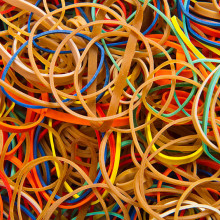
46:12 - Science Centre: Rubber Band Fridge
Science Centre: Rubber Band Fridge
with Dave Ansell, Ginny Smith, The Naked Scientists
How can you make a tiny fridge using an elastic band? Ginny Smith and Dave Ansell 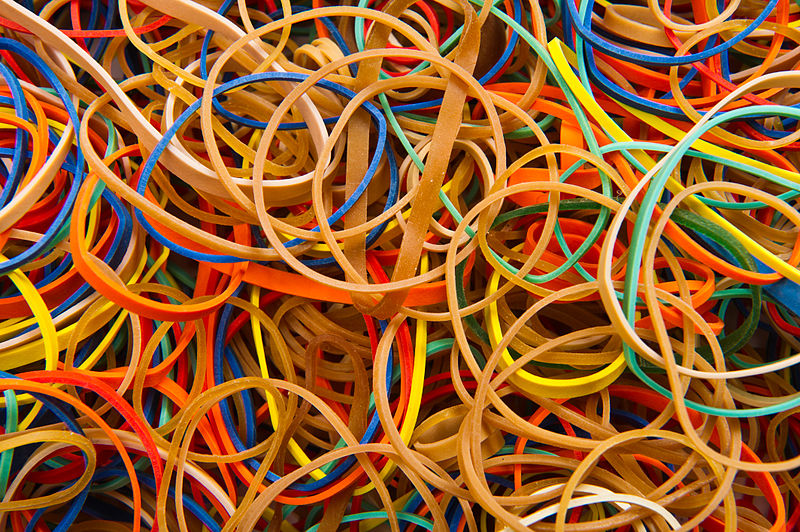 find out...
find out...
Ginny - Okay, if everyone looks under their chair, you should find a rubber band. So, we're going to need your help for this one and we're all going to have a go at this experiment together. Our panel I think has a rubber band, each of them? Good. So Dave, what do you need us to do with these rubber bands.
Dave - So, these are perfectly normal rubber bands. Hopefully, you've all found them and what we've going to be doing is looking at the temperature of the rubber band. Now, about the most sensitive part of your body for measuring temperature is your lips. So, what I want you to do is touch the rubber band to your lips and get an idea of what sort of temperature it's really like.
Ginny - Now, we're mainly doing this to make you look silly.
Dave - Everyone with rubber band moustaches, it looks wonderful from up here I can say. And then what I want you to do, if you stretch the rubber band slowly, you'll find the point where it starts to get quite stiff. Can you feel that? Okay, so what I want you to do is let it unstretch. Now, feel the temperature on your lip. Take it off then quickly stretch it to the point at which it gets stiff and then feel it again. And then leave it out and let it unstretch and feel it again and if you feel any difference.
Ginny - So, if we go over to our panel, you guys are having a go at this? So, can you feel anything different?
Rod - It feels warmer when you stretch it.
Ginny - Brilliant! Is that what everyone else is finding?
Crowd - Yes.
Chris - There are some pretty weird looking people here.
Ginny - Yeah, I think...
Chris - Elastic band moustaches.
Ginny - It's a good look. So, all we've done is stretched a rubber band and it's got warmer. Why?
Dave - So, that kind of make sense. As you stretch it, you're putting a load of energy into it and that energy must be going somewhere and in the case of the rubber band, it's going into warming up the rubber band. So, the rubber band has got warmer as you stretch it. Rubber is actually quite a strange material. It doesn't behave like a normal material. If you stretch a piece of steel or any other alloy, you kind of stretch bonds in the molecules and you kind of store energy. But rubber is different. Rubber is made up of great big long molecules. It's a bit like this piece of rope. When you stretch it, you're not stretching the bonds. What you're doing is just straightening out the molecules. Now, did you notice what happened when you let it shrink again?
Ginny - So, everyone is saying it got colder when they released it and then felt it again.
Dave - That's right because when rubber unstretches, what basically happens is that you've pulled out your rubber molecule and made it nice and long and straight, and then you let heat, so all the molecules inside are bouncing around because they're hot. Everything is jiggling. As it jiggles, it kind of jiggles around and gets more zigzaggy and get more wriggly. And so, it gets shorter.
Ginny - So, what Dave has got here is he's got a piece of rope which is pretending to be the molecules inside the elastic band and when he wiggles them about. Of course, the rope sort of makes waves, goes all snaky and then the length of it get shorter because it's moving around more, and that's what's happening inside the rubber band.
Dave - That's right and as the molecules bash into it, they lose a little bit of energy and they get colder. So, as the rubber band pulls against your fingers in order to shrink, the molecules lose some energy. They're actually losing it to your fingers if you pull in and it gets colder and you can actually feel that on your lips. You have effectively made a very, very small, very inefficient fridge.
Ginny - So, when you're hot and probably not at the moment because it seems to be absolutely freezing outside, but if we ever have a summer again, you just need a few rubber bands and you can cool down with no problem.
Dave - I'd like to see the machine.
Chris - Thanks, Dave and Ginny. So, any questions about elastic band physics? One just here.
Freya - Doesn't the rubber band have the temperature of the room temperature or is it its own temperature?
Dave - So, if you leave a rubber band for a long time, it will get the room temperature. And actually, that's kind of why it works as a fridge. If you stretch it, it gets hotter and if you leave it for a while, it'll get back to the room temperature because the heat will leave it because it's hotter than the rest of the world. Then as you unstretch it, it kind of itself gets colder. And so, it cools down a bit and then again, if you leave it for a long time, it'll warm up. So, if you leave it for long enough, it will get to the room temperature.
Chris - One just here.
Grace - Hi. My name is Grace and I've wondered what makes a magnet magnetic.
Ginny - So, magnets have little poles inside them. They have little elements that have to line up to make them magnetic. So, if you've ever wanted to make a magnet, you can do it by using another magnet to rub along a piece of iron or something like that. What that does is it lines up all these little poles inside them and if they're all pointing in the same direction, you get a magnet. You have to be really careful with magnets because you can demagnetise them if you jumble all those poles up again. So if you drop a magnet hard enough, it'll jumble them all up and then it won't be a magnet anymore. And also, if you heat it up. So, like we were just talking about, when you heat things up, everything inside it gets really excited and jumbles around. So, if you put a magnet in a flame, you can demagnetise it as well.
Dave - If you get to really fundamental things as to why anything is magnetic, magnetism is kind of effects of electric current. If you get an electric current flowing, you get a magnet. So, if you put a wire around and round and round, you get an electromagnet and you can put current through an electromagnet. Actually, in a magnet, on average, you have more electrons going around the atoms in one direction than the other direction. So actually, even permanent magnets are little electromagnets and yes, they become magnetic.
Chris - There's a question at the back here.
Lily - I'm Lily and you said when you stretch the rubber band, you made an inefficient fridge. So, how does a fridge really work?
Dave - Okay, so a fridge sort of does something similar by using gas. So, if you squash a gas - I don't know if you've ever pumped up a bicycle tire very, very quickly. The end of your bicycle pump gets quite warm. So, if you squash a gas, the gas gets hotter. So, what's happening at the back of your fridge is, there's a pump which squashes the gas then it gets hotter. It then has that long wiggly tube at the back which loses that heat. You then set the squashed gas which is at room temperature, goes inside the fridge and is let to expand. If you expand a gas, it cools down again. So, if you've ever used an aerosol can for long time, it starts getting really, really cold. So you let the gas expand inside of your the fridge, then it gets cooler, sucks energy and heat out of your food, then get cycled back around to the pump and get squashed then the heat is lost. It goes round and round, and round and the fridge gets colder and colder.
Chris - Fridge in three easy steps. Last question down the front. You've got a question for us? What's your name?
Jacob - Jacob.
Chris - What would you like to know, Jacob?
Jacob - I want to know if we snap a rubber band, would it still do the same things?
Ginny - Yes. So, if you snap a rubber band, all that's happening is that those molecules there have pulled apart, but if you used a different area of it, it would still work. Probably, it wouldn't work so well if you used it right at the end because there's not much to stretch there. But yeah, it should still work.
- Previous Who's your Bronze Age Ancestor?
- Next eLife Episode 4: Undead Cells




Comments
Add a comment